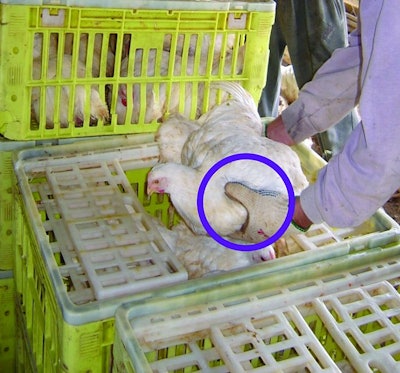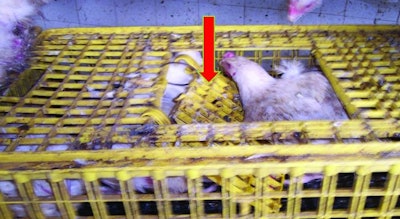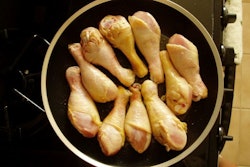
One of the poultry processing industry’s major challenges is how to minimize losses of saleable product.
The causes of the losses may be found both at pre-slaughter and at the plant itself. They include poor bird management, deficient infrastructure, ignorance of birds’ stress reactions and an inadequate working culture.
Pre-slaughter
Birds will have been reared in calm and quiet conditions. Whether houses contain enclosures or not, the capture team will need to group them together to ensure a regular supply of birds for caging, allowing the trucks to depart for the slaughter plant on time.
This process, however, must be completed in a disciplined manner if birds are not to be harmed. It is essential that workers move slowly within the house if scratches, bruises, bleeds and broken bones are to be kept to a minimum. Stressing birds, which may have fatal consequences, must be avoided.
Broiler capture
If capture by the leg is practiced, it must be done with care to avoid bruising. Similarly, when birds are captured by the body, wings must be held close to prevent wing flapping, but the pressure applied must not be so great as to affect breathing.
Caging broilers
When workers place birds into containers or cages, they need to put the bird into an empty space and try not to disturb the already-caged birds. This will help to prevent territorial aggression, which could result in skin damage.
Many poultry houses have lamps installed that project red, green or blue lights to promote calm. A more economical approach is to use the lights of the forklift trucks, directed towards where containers are stacked. However, with this approach, there will still be areas of the house that remain dark.
The risk with using headlights is that, without proper illumination, birds may be knocked when placed into the containers or cages. This can cause bruising that only becomes apparent when birds exit the last plucker.
To remedy this situation, some companies use night vision that projects a blue light. This offers the advantage of improving worker vision while helping to keep birds calm, making capture more efficient.
The use of these glasses can help to ensure that birds are captured correctly, that the capture team can walk with more security and safety, reducing the risk of accidents, and that work rhythm is maintained, ensuring that the trucks can leave the farm on time.
Loading trucks for the plant
Delivering empty cages and loading full cages onto the truck usually requires a forklift loader. The noise generated by forklift trucks with an internal combustion engine can raise birds stress levels and, increasingly, forklifts powered by gas and electricity are now used. Both alternatives are silent.
State of cage repair
No matter how much care is taken by the harvesting team, if cages are the wrong size or in poor condition their efforts will have been in vain. All cages or containers must be in a good state of repair; there must be no broken areas or openings that cannot be properly covered.
The height of the containers must reflect the average live weight of the birds being caged. Should this not be the case, broilers’ wings, breasts and shoulders may be bruised. This is particularly the case should truck drivers not comply with company regulations covering, for example, cruising speed and speed reduction on curves and when passing over speed bumps.
Dead on arrival birds
If trucks are not equipped with the correct infrastructure and technology to keep birds comfortable, many will be found dead when removed from the containers. In hot climates, not more than 0.05%-0.1% of trucked birds should be dead on arrival, while in cold climates the percentage should be below 0.05.
At the processing plant
There are certain activities in particular that will influence the volume of rejects at the processing plant.
Where stunning is concerned, birds must approach the stun bath completely calm.
Stressed birds will flap their wings leading to an accumulation of blood. Passage over the access ramp should take no less than 20 seconds and no more than 30 seconds – any longer and blood will accumulate in the wings. Keeping birds calm at this stage will help to reduce the occurrence of pre-shock, which can lead to bruising.
The stun bath must be set correctly. Should birds receive an excess of electric current, they will suffer excessive muscle contraction, which can affect plucking and quality.

Bleed time also needs to be carefully monitored along with the variables governing scalding. Heat should not be lost from the carcasses as birds travel from the scalder to the plucking machines, and plucking must be distributed evenly across all the machines.
The water used to stop crystallization of the plucking machines’ rubber fingers, and to keep them free from feathers, should be kept at 34-38 C. Pluckers should be sequentially inclined downwards towards the exit, so increasing the efficiency with which wing feathers are removed. If plucking is correctly adjusted to the size of chicken being processed, damage to skin and wing dislocation are kept to a minimum.
If each stage of preslaughter and processing is carried out as it should be, the volume of Grade A chicken meat produced will increase, while the cost per kilo will fall.















